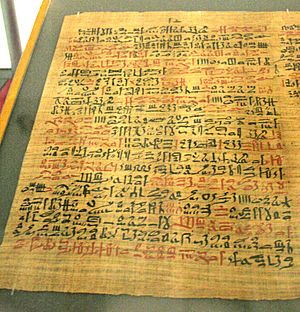Ebers papyrus facts for kids
The Ebers Papyrus is a very old Egyptian book about medicine. It was written around 1550 BC, which is over 3,500 years ago! This special papyrus (a type of ancient paper) contains many secrets about how ancient Egyptians tried to heal people. It includes both practical ideas and some magical beliefs they had about health.
Contents
The Ebers Papyrus: Ancient Egyptian Medicine
What is the Ebers Papyrus?
The Ebers Papyrus is one of the oldest and most complete medical texts ever found from ancient Egypt. It's like a huge textbook for doctors from a very long time ago. This amazing document is over 20 meters (about 65 feet) long! It was discovered in the city of Luxor, Egypt, in the 1870s. It is named after Georg Ebers, who bought it.
Ancient Treatments and Remedies
The papyrus describes more than 700 different drugs and treatments. Some of these ideas were quite useful. For example, it suggests using opium to help with pain, which is still used in medicine today.
However, some treatments might seem strange to us now. One example is tapping a person on the head with a fish to cure a migraine. This shows how ancient Egyptians mixed their understanding of the body with their beliefs about magic.
Ailments and Conditions
The Ebers Papyrus covers a wide range of health problems. It talks about issues like stomach problems and eye infections. It also discusses more complex conditions, such as depression or other mental health issues. This shows that ancient Egyptians thought about many different parts of health.
The text also includes information on how to examine patients. It describes how to check for symptoms and make a diagnosis. It even has sections on how to set broken bones and treat wounds.
Medical Knowledge in Ancient Egypt
The Ebers Papyrus helps us understand how advanced ancient Egyptian medicine was. They had a good knowledge of anatomy, which is the study of the body's structure. They also understood how some plants could be used for healing.
However, their medical practices were also mixed with religious beliefs. Many treatments involved spells or charms. They believed that gods and spirits could cause or cure illnesses.
Images for kids
See also
 In Spanish: Papiro Ebers para niños
In Spanish: Papiro Ebers para niños



